First Sacred Habit (March 25, 1843)
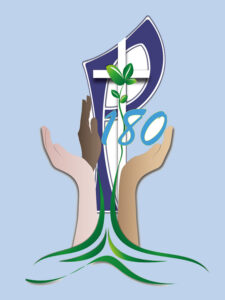 « Nothing is more constructive to a religious family than the frequently revived memory of its origins. »[1]
« Nothing is more constructive to a religious family than the frequently revived memory of its origins. »[1]
What could be a better way to open this text than to quote these words highlighting the 180 º anniversary of the founding of the Congregation of the Sisters of Providence?
Nonetheless, this great story begins in 1826, sixteen years before the founding of the Community, when a unique woman, familiarly known as Emilie, embraced her pain while transforming it into love for others, following the example of Our Lady of Seven Sorrows.
We know her story. We know her work and her future heritage. She did not leave many writings herself, but others took up the task of raising awareness about her work and her love.
For most people, Emilie Gamelin is just the name of a public square in Montreal, occupied by a great number of unhoused persons and a usual meeting point for popular demonstrations. Precisely in this point of connection, the congregation took root 180 years ago. The place was genuinely a sanctuary, a safety net for thousands of outcasts during a time when social welfare was almost non-existent.
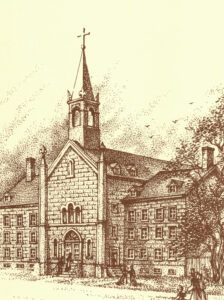 At the moment of its foundation, the works of the Providence Asile, also the first Mother House, were, “To accommodate, feed, and clothe the aged and infirm women, orphans, and other people living at the Asile; to visit the home of the poor and the sick, to care for the sick, to visit the prisoners and to console those who suffer, and, to engage in all sorts of charities. Our labor and services will not be restricted to the city, but shall extend to the countryside, whenever our superiors deem it appropriate.”[2]
At the moment of its foundation, the works of the Providence Asile, also the first Mother House, were, “To accommodate, feed, and clothe the aged and infirm women, orphans, and other people living at the Asile; to visit the home of the poor and the sick, to care for the sick, to visit the prisoners and to console those who suffer, and, to engage in all sorts of charities. Our labor and services will not be restricted to the city, but shall extend to the countryside, whenever our superiors deem it appropriate.”[2]
Emilie’s words were few but her actions spoke volumes. She worked relentlessly to protect all those in need and shelter them under her roof. With open arms, she distributed food and clothing. With an open heart, she offered her prayers and her empathy.
Émilie’s actions weighed more than her writings, and her work is representative of her image: Larger than life. Soon she became irreplaceable for the diocese of Montreal. “[Existing charitable establishments] do not yet respond to all the different needs, nor to all classes of woes and misfortunes. We therefore think, especially today, of founding through you and counting with you, a stable and pious institution which will be a safe refuge for all those suffering from any disability or affliction, form ignorance or poverty, and who expect from our Catholic Church ease and relief.” [3]
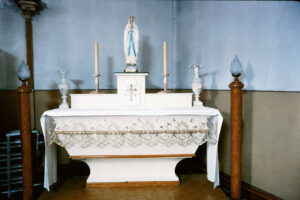 In order to ensure its sustainability –of which Émilie was the director- the intention of Mgr. Ignace Bourget, bishop of Montreal, was to entrust this new institution to a religious congregation. Several different circumstances lead to the creation of the Sisters of Providence, the most important of which was the refusal of the Daughters of Charity of Saint-Vincent-de-Paul in France to settle in Montreal.
In order to ensure its sustainability –of which Émilie was the director- the intention of Mgr. Ignace Bourget, bishop of Montreal, was to entrust this new institution to a religious congregation. Several different circumstances lead to the creation of the Sisters of Providence, the most important of which was the refusal of the Daughters of Charity of Saint-Vincent-de-Paul in France to settle in Montreal.
A new type of apostolic religious life, where direct work with people took precedence over cloistered life, was especially appealing to women like Emilie, who were willing to devote their lives to help their neighbors in a practical way.
As the Providence Asile was being built, Emily opened the doors of her Yellow House (Maison Jaune) to the first candidates of the new congregation for their formation, a formation in which Emilie also shared even if dressed in her “Lady’s habit.” [4] Amidst this pious ambiance, she would consecrate herself to the destitute. Even before embracing religious life, on February 2nd, 1842 she proclaimed: “To live the rest of my life in perfect continence […], to be faithful to this cause all my life […], and to be the servant of the poor to the best of my ability …this is my prayer.” [5]
Emily might have been ill at ease when writing, but her compassionate heart, laden with the sorrows of the world, would find in her actions her own way of expression. Under her own roof, she observed the first seven candidates —the same number of the sorrows of our Heavenly Mother— as they prepared for receiving their habits. From a spiritual point of view, they made a retreat and completed a novena; from practical one, they needed to make their habits.
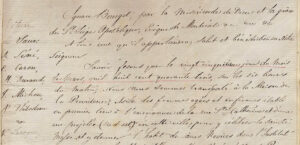
Délibérations du conseil général et admission des sujets 1840-1858, feuillet 2, 25 mars 1843.
March 25, 1843 was a big day at the Yellow House. In the presence of a deeply touched Emilie, Mgr. Bourget gave the sacred habit to the seven candidates: Agathe Sené (Sister Zotique), Émilie Caron (Sister Caron), Madeleine Durand (Sister Vincent), Justine Michon (Sister of Our Lady of Sorrows), Marguerite Thibodeau (Sister of the Immaculate Conception), Victoire Larocque (Sister Larocque) et Delphine Payement. Thus, the Congregation of the Sisters of Providence was officially opened.
180 years ago, Mgr Bourget addressed the following words to the novices: “As the Archangel Gabriel announced to Mary the mystery of the Incarnation, so I announce to you on behalf of the Church that you will be responsible for caring for the poor, acting as their mothers. As the angel also told Mary not to fear, so I tell you, do not fear, little flock, Grace will not fail you. Crosses to bear, you will have without question. You do not have a mistress of novices, but I entrust you to the care of the Blessed Virgin. I hope she will be willing to be your teacher. During your sorrows, your worries, you can turn to our Kind Mother; I am not afraid to entrust you to the guidance of such a majestic teacher.” [6]
A few years later, the prelate would write to Mother Caron, the Superior General, confiding in her his doubts about such an unprecedented occasion in Montreal —the founding of a religious congregation. “What will become of these good girls, who were abandoning themselves to me with such confidence? […] Here they were, forever lost and destined to wither in the eyes of society, if success did not come to crown their gentle disposition […] That is why I conducted the ceremony of the first habit with unspeakable anguish for you […] the most ardent hope that I can wish for is that you never forget your origins.” [7]
But when in July 1843, from the original seven candidates, after the departure of Delphine Payement, only six remained, , Madame Émilie had just to take one final step to become Sister Gamelin. A giant step. She was not only changing her secular life for a consecrated one, but also giving up her independence by the vow of obedience. Her path was strewn with pitfalls, but she never questioned the Lord’s call to her. Grace triumphed over nature in this “great, long and hard struggle,” [8] as Bishop Bourget described it.
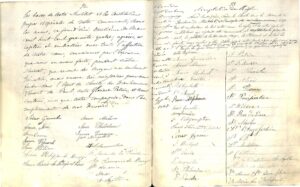 Before exchanging a women’s bonnet for the religious headpiece, the Bishop entrusted Emilie with a mission of the most importance, that of going to the United States to find the Rules of Saint-Vincent-de-Paul. About a month later, faith in Our Lady of Sorrows was renewed, as six candidates became seven again. And then, Emilie’s life took a turn, one she had longed for. She became the fourteenth novice on October 8, 1843. She was nevertheless the first one of the group to pronounce the four vows[9] on March 29, 1844. The next day, Sister Gamelin was elected General Superior of the nascent congregation.
Before exchanging a women’s bonnet for the religious headpiece, the Bishop entrusted Emilie with a mission of the most importance, that of going to the United States to find the Rules of Saint-Vincent-de-Paul. About a month later, faith in Our Lady of Sorrows was renewed, as six candidates became seven again. And then, Emilie’s life took a turn, one she had longed for. She became the fourteenth novice on October 8, 1843. She was nevertheless the first one of the group to pronounce the four vows[9] on March 29, 1844. The next day, Sister Gamelin was elected General Superior of the nascent congregation.
Emilie, Sister Gamelin, Mother Gamelin, Blessed Émilie Tavernier-Gamelin. There might be just a few examples of her writing left, but her charitable work is there to cement her legacy. Her actions in favor of the destitute of society were the starting point for her receiving the habit of a religious sister on March 25, 1843.
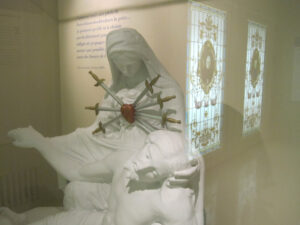
Photo prise par Marie-Claude Béland, archiviste, 2012
“The labor that would give birth to our Institute went through a slow and gradual growing process before blossoming freely in broad daylight, and spreading its benign influences far and wide…” [10]
Let us give thanks to Emilie and the first candidates who, over the past 180 years, have inspired more than 6,200 Sisters of Providence to consecrate themselves to God, following their example.
By Marie-Claude Béland, archivist,
Archives Providence, Administration générale.
[1] From Biographies de la Mère Gamelin et de ses six compagnes fondatrices de l’Institut des Filles de la Charité Servantes des Pauvres dites Sœurs de la Providence de Montréal, Providence Maison Mère, Montreal, 1918, p. 11.
[2]Cfr. Positio Aemiliae Tavernier, viduae Gamelin, Rome, 1989, p. 135.
[3] From Mandement d’Institution des Dames de la Providence pour l’Asile des femmes âgées et infirmes, Montreal, 6 novembre 1841.
[4] Positio, op. cit., p. 136.
[5] Idem, p. 125.
[6] Notes historiques Sœurs de la Providence 1799-1893, Providence Maison Mère, Montreal, 1922, p. 30-31.
[7] Letter from Mgr. Ignace Bourget to Mère Émilie Caron, April 2nd 1856. Archives Providence Montréal.
[8] Positio, op. cit., p. 132.
[9] From 1844 to 1868, Sisters pronounced four vows: poverty, chastity, obedience and serving the poor. The fourth one was suspended by Rome on August 10th, 1868, to establish the same number of vows for every congregation. Ibid, p. 153, note 80.
[10] Biographies […], op. cit., p. 12.



